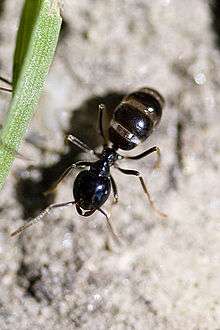Lasius fuliginosus
| Lasius fuliginosus | |
|---|---|
 | |
| Lasius fuliginosus worker | |
| Scientific classification | |
| Kingdom: | Animalia |
| Phylum: | Arthropoda |
| Class: | Insecta |
| Order: | Hymenoptera |
| Family: | Formicidae |
| Subfamily: | Formicinae |
| Genus: | Lasius |
| Species: | L. fuliginosus |
| Binomial name | |
| Lasius fuliginosus (Latreille, 1798) | |
Lasius fuliginosus, also known as the jet ant or jet black ant is a species of ant in the subfamily Formicinae. Workers have a black shiny colour and a length of about 4–6 mm, females are larger (6–6.5 mm) and small males reach a length of 4.5–5 mm).[1] The head is heart-shaped.
Distribution
The species has a wide distribution in Europe and Asia, from Portugal and Ireland in the west, Finland in the north to Italy in the south, and eastwards to Korea and Japan.[1][2] In the UK, records suggest that while occasionally found further North before 1970, it is now found mostly south of The Wash, in East Anglia and Southern England, with a few colonies found in Ireland. [3]
Environment
The species builds a "cardboard" nest in old hollow trees, using "board" – a mixture of chewed wood with saliva. Like other black ants they tend populations of aphids for their honeydew, and can often be seen travelling in both directions, following scent-trails for long distances to their source of food, which is often a tree. They rarely carry other insects back to the nest. A nest contains only one queen, but a large colony can contain as many as 15,000 workers.[4]
Reproduction as a hyperparasite
While other black ants such as Lasius niger, the smaller but much more common (in the UK) species, a queen founds its own nest by laying eggs and then feeding the new larvae with a fluid produced by breaking down its own muscles; a process that leaves her terrible weak as she cannot tend the larvae and forage for food at the same time. A post-nuptial queen of Lasius fuliginosus cannot found her own nests, but establishes a nest through social parasitism in another species of the same genus - Lasius umbratus, a rare yellow ant with an underground habit (unlike the common yellow ant Lasius flavus which makes small mounds in grass and lawns). She kills or ousts the existing queen and lays eggs, which the existing workers tend. Her offspring workers then slowly take over the nest. Lasius umbratis also establishes its nest in a similar way, by taking over the nest of Lasius niger, the common black ant, so Lasius fuliginosus is sometimes referred to as a hyperparasite.[4]
References
- 1 2 Collingwood, C. A. (1979). "The Formicidae (Hymenoptera) of Fennoscandia and Denmark" (PDF). Fauna Entomologica Scandinavica. 8: 1–174.
- ↑ Collingwood, C. A. (1982). "Himalayan ants of the genus Lasius (Hymenoptera: Formicidae)" (PDF). Systematic Entomology. 7: 283–296. doi:10.1111/j.1365-3113.1982.tb00446.x.
- ↑ Partridge, John. "The Jet Ant - Lasius fuliginosus". Worcestershire Biological Records Centre. Retrieved 13 October 2016.
- 1 2 "Black ant". Buglife. Retrieved 13 October 2016.
External links
 Media related to Lasius fuliginosus at Wikimedia Commons
Media related to Lasius fuliginosus at Wikimedia Commons